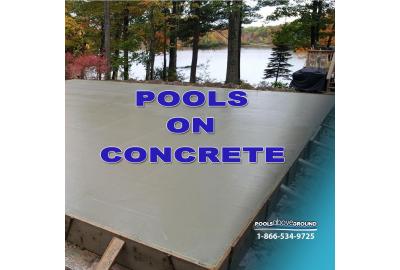Not every house comes with the perfect yard for a pool. Perhaps your yard is sloped or uneven. Perhaps it's rocky or sandy. Maybe you don't have a yard at all. In this situation, many families feel they're just "out of luck" and will have to live without a pool. Others will start to wonder whether or not they can simply put an above-ground pool on a concrete surface. Below, I'll do my best to answer this question.
The Concrete Must be Level
90% of above-ground pool installation is ensuring that the ground underneath the pool is nice and level. After all, if you have even the slightest buckling in the walls of your pool, you're more or less guaranteed to have issues down the line, including everything from leaks to full-blown wall collapses. The same rule applies to concrete. If you want to install a pool over a concrete slab or section of your driveway, you need to ensure that the entire section is smooth and level. Now, if you find that your concrete is NOT level, you don't necessarily have to give up hope. However, you do need to take a few extra steps. In the past, I've used roofing shingles to raise footplates and rails, laying them so that they support the pool's frame in all the right areas. Of course, you'll also want to use an Armor Shield and pool cove kit in this situation, just as if you were installing the pool on the lawn. Another option is to build a wooden frame overtop the concrete. This is almost a must when installing oval above ground pools. The different levels at which the pool frame sits makes a concrete slab troublesome. The sandbox method allows you more control over the pool's levelness while allowing you to adequately compensate for any dips in the slab. I also recommend you fill the inside of the frame with clean sand or clean fill dirt. This will ensure the wooden frame itself is sufficiently supported and keep it from warping over time.
Make Sure the Concrete is Solid
If you're particularly lucky, and the section of concrete turns out to be nice and level, you next want to check for cracks and imperfections. If you find any, they need to be filled with concrete patch solution or liquid nails. Remember, once you fill this pool with water, you're going to be putting a tremendous amount of strain on the concrete below. Failing to ensure your foundation is solid now will only cause big problems later. If installing your above ground pool on concrete with the sand box method you could pass on the pool cove and Armor Shield pool floor pad and just use the sand or dirt that's within the box for your pool bottom. I've seen pools that used other materials like carpet, blankets, wood etc. and they never work out. These materials either rot over time or stain your pool liner. Personally I like using a pool floor pad and cove kit and would use them even in this situation.
In Conclusion
In the end, if you have to put your pool on concrete, you can. However, you'll need to take a few extra steps to ensure that concrete is suitable for the job. Of course, you can also consider having a raised concrete slab installed specifically for your pool. This is probably too expensive to be a reality for most but it can be done. If you hire a professional, they're sure to be up to the task of creating a smooth, level surface for your installation.


